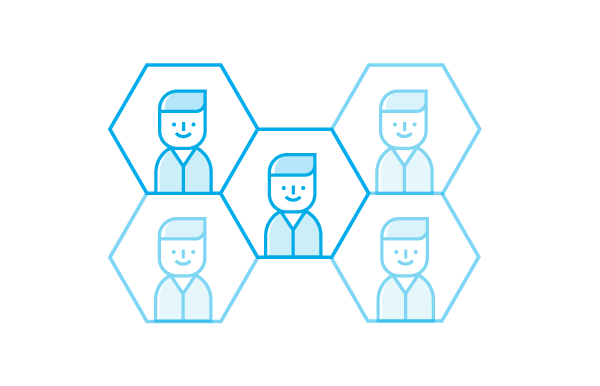- How to use look-alike modeling in marketing?
- Data monetization and creating look-alike audience
- Customer data analysis aimed to find the best look-alikes
- Classifying customers by machine learning algorithms in look-alike marketing
- Case study: Big data marketing and look-alike modeling in the online campaign
- How to create your own look-alike segments?
Overview:
- How to use look-alike modeling in marketing?
- Data monetization and creating look-alike audience
- Customer data analysis aimed to find the best look-alikes
- Classifying customers by machine learning algorithms in look-alike marketing
- Case study: Big data marketing and look-alike modeling in the online campaign
- How to create your own look-alike segments?
Look-alike segments help you find clients who behave like your best converting customers. First, machine learning algorithms analyse profiles of users who buy your product and next, in external databases, they are finding new audience group (look-alikes) with a list of attributes similar to your current clients.
Find out how to build look-alike segments and use them in programmatic advertising.
How to use look-alike modeling in marketing?

Look-alike modeling is a methodology used for finding new clients who behave pretty similar to your current customers. In other words, machine learning algorithms analyse behaviour and attributes of clients who buy your products most often and next – search for clients with a similar profile in the external database to display them targeted ads.
Look-alike modeling techniques are great for marketers because it is very likely that look-alikes – who can come from all around the world – will visit the advertised website or buy a specific product. So the perspective of expanding your business and increasing sales is really attractive.
In other words, creating and targeting look-alikes helps marketers to optimize campaigns: in terms of quality (a very select group of look-alikes) or quantity (a wide range of look-alikes).
Data monetization and creating look-alike audience
The more information about clients data providers have, the bigger look-alike segments they can build. Companies can collect data from various sources, e.g. from online publishers, who gather information about readers and can easily monetize it. Thanks to data monetization companies are instantly opening a new revenue stream.
OnAudience.com cooperates with many publishers from various markets mainly in Europe and North America. It allows us to provide billions of internet users’ profiles. This huge amount of customer data helps us creating either precise look-alike segments with a list of specific attributes or a broad range of profiles similar to best converting customers.
Customer data analysis aimed to find the best look-alikes
Finding look-alikes is the second step. The first one is to deeply know your current clients’ profiles. How do we do it? We prepare Audience Insights reports – behavioural reports that show what attributes have your online clients. We analyze your website traffic and compare the occurrence of specific attributes of your online users to the whole population of your country.
In this way, we identify the best converting profiles, we know which attributes differentiate your best clients from the whole population. And on that basis, we can start looking for similar profiles – look-alikes.
We are looking for look-alikes basing on a set of attributes, such as:
- demography – age, gender, income etc.
- interest – automotive, news, travel, etc.
- purchase intentions – finance, real estate, software etc.
Classifying customers by machine learning algorithms in look-alike marketing
To describe your customers by a set of attributes, we use machine learning algorithms that are analysing digital moves of your clients. Every visited website is an information for our AI system. If one of your clients often visits websites with many articles about cars, he or she is probably interested in Autos.
To categorize domains visited by online customers, we apply our own model that use machine learning algorithms. On the basis of open catalogues that collects thousands of websites, our model learns what combination of words fits into which categories.
Our classifier read and analyze websites’ content and on that basis, decides what is the subject area of the visited page. When your customers visit many sites about cars, pets, or read news – AI describes his or her interests as Automotive, Animals & Pet and News.
Case study: Big data marketing and look-alike modeling in the online campaign
The effects of using look-alikes in campaigns are impressive. Take a look at this case study, where Audience Network – a data consulting company from our capital group – used our 3rd party data and look-alike modeling for precise targeting online audience.
The campaign
Audience Network runs a campaign promoting Wroclaw city in European Best Destinations 2018 competition. The purpose of the campaign was to win the competition, in which rivals were among others Prague, Paris, Barcelona or Amsterdam. Internet users voted for the best destination. We decided to use look-alike techniques to achieve the high efficiency of this campaign.
Execution
Firstly, the agency analysed the profiles of users who visited wroclaw.pl or visitwroclaw.eu websites. They found the best converting users and created a behavioural profile to precise define target audience.
To widen the target group, the agency used look-alike modeling. The created segment included profiles of users with attributes similar to the best converting group that had been identified before.
Targeting look-alikes made it possible to reach out to the wide range of users. To find the best look-alike profiles, we used our data warehouse, which contains over 21 B user profiles. By selecting specific attributes, we’ve found the right group of look-alikes to display them personalized ads.
Effects of using look-alike modeling
As a result of the campaign, Wroclaw won in the European Best Destinations 2018 competition. Over 41 thousands of users voted for Wroclaw, from which over 27 thousand (67%) of votes thanks to the conducted ad campaign.
How to create your own look-alike segments?
To find look-alikes, first – get to know your audience well. Check the profiles of your best converting clients and then start to search for similar profiles in external databases. Reaching out to more clients is the best way to increase your sales and find new, loyal customers.




